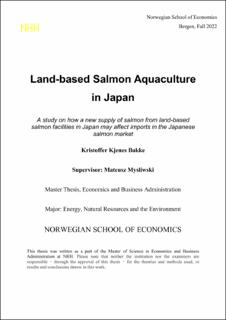Land-based Salmon Aquaculture in Japan : A study on how a new supply of salmon from land-based salmon facilities in Japan may affect imports in the Japanese salmon market
Master thesis
Permanent lenke
https://hdl.handle.net/11250/3054619Utgivelsesdato
2022Metadata
Vis full innførselSamlinger
- Master Thesis [4372]
Sammendrag
This study’s research question is how a new supply of domestically sourced salmon from
land-based facilities in Japan may impact imports to the Japanese salmon market. By using
import statistics and domestic data from the Tokyo wholesale market, I estimate the
Armington elasticity between foreign and domestic salmon. This elasticity provides an
estimate of the level of substitution of different products of salmon from several countries,
which provides insights to how the different imports will react to domestic changes in volume
and price. My findings show that there are significant differences in the Armington elasticity
between different imports, especially between fresh and frozen salmon. Furthermore, I
modelled how two imports displaying a different level of substitution, fresh Atlantic salmon
from Norway and Australia, may be affected by the domestic changes differently. These
projections found that Norway, with a lower estimated Armington elasticity, is much more
resistant to domestic changes compared to Australia.
